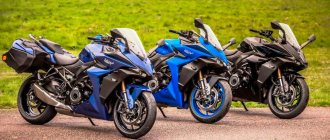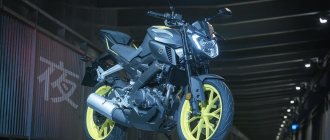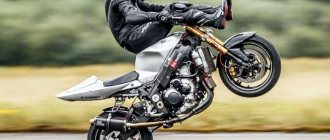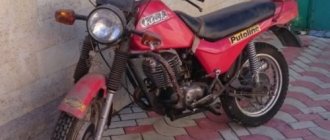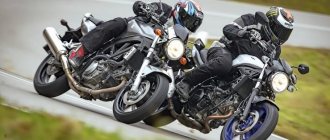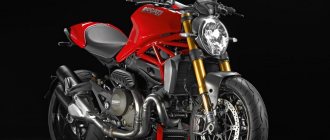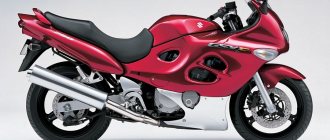Having received a sportbike, which in 2005 was officially recognized as the best motorcycle of the year, I decided to take my time and carefully examine the black creature before the first ride. It seemed that the bike came to us from other worlds. Crystal headlight, black wheels, black DLC coated fork (1), tank, plastics with a mix of glossy and matte parts, dash with a stunning combination of orange and black, graceful tail, LED tail light, turn signals and an absolutely otherworldly look. muffler - all this was a little reminiscent of the classic GSX-R in white and blue. Previously, Suzuki paid less attention to the design of its superbikes, but now it is a completely different matter. The recognized beauty queen - Yamaha R1, seems to have found its king. But if the beauty of the R1 is feminine and sophisticated, then the new GSX-R is like a black cardinal. Discreet, smart and strict.
In terms of comfort, the jixer is classified as a “tourist” among sportbikes
The very first minutes in the saddle of the jixer made a strong impression. Compared to many “liters” from other companies, the saddle is so narrow that it makes you feel like there is nothing between your legs! This feeling is aggravated by the ultra-light weight of the motorcycle - the lowest in its class. Just a year ago, this weight would have been the envy of some six-hundreds. The riding position is surprisingly comfortable, at least by purebred sportbike standards. The clip-ons are positioned precisely to provide maximum front-wheel feel while still keeping the riding position quite civilized. Apparently, the footrests, which are not located too high, also contribute to comfort.
The jixer key is equipped with an immobilizer system chip
The key with the SAIS system chip (2) is in the “ON” position. On the dashboard, the red light with the image of the key blinked twice - the chip was identified. The electric fuel pump hums for a few seconds and then goes silent. Press the starter button and the engine starts instantly, only to stall after a few seconds. Quite unusually, the same thing happens the second time. Finally, on the third try, the engine starts and no longer stalls. The digital thermometer on the dash reported that the temperature had reached 75 degrees. It's time to go. From the very first meters you feel how enormous the torque is at low revs. (3) The motorcycle responded to a gentle turn of the throttle with not just a confident start, it pulled, calling for respect. But after a few minutes the tension disappeared.
You have just been overtaken by a “liter” jixer
The nature of the engine turned out to be so linear and elastic that there were no difficulties with dosing power. After driving through small puddles, the rear wheel smoothly went into slip, and after a few seconds it just as smoothly gained reliable contact with the asphalt. During vigorous acceleration, dosing gas is so simple that you can select the acceleration mode with high precision: here we are accelerating so that the rear suspension is loaded, we add a little gas - and the front tire no longer sticks to the asphalt, but scrapes along it. Well, if we want, we can lift the front wheel completely into the air. The acceleration is thermonuclear. If you maintain full throttle for more than ten seconds, you can easily end up in orbit! Or in the hospital...
Fat torque comes in handy when exiting corners
The predictable nature of the engine simplifies the driver's task not only on the straights. Accelerating energetically out of corners is a real pleasure. The high torque helps here too: you can catapult out of a bend in a higher gear without losing acceleration but saving one upshift. Thanks to its elasticity and strong torque, you can drive in the city in almost any gear. If the mood is calm, then fourth, fifth, even sixth gear will do the trick in most cases. It was not possible to provoke the engine to jerk. Of course, this is the merit of the SDTV system. If you need to break away, then already the first (by the way, quite long) gear will allow you to almost double the legal speed on a country highway: you managed to reach more than 160 km/h according to the speedometer!
Limited edition jixer - all in black
The engine and gearbox match. The gear ratios are chosen very well. The interval between first and second is quite large (as in any racing-type gearbox with close ratios), and the remaining gears are designed so that after shifting up near the red zone, the speed drops exactly into the maximum power range. At the same time, the bike encourages you to shift without pressing the clutch, and the gearbox operates accurately and silently.
When brazenly shifting down two or three gears, it is impossible to lock the rear wheel
The perfect gearbox is complemented by a slipper clutch. Its work is so harmonious that even with impudent downshifts of two or three gears, it is almost impossible to feel when slippage begins. At the same time, it was not possible to block or let the rear wheel skid when braking the engine. Even on wet roads. The clutch lever turned out to be somewhat stiffer than usual. Because of this, someone may need to quickly relearn to use three fingers instead of two.
Feedback from the front wheel when entering corners after adjusting the suspension is very good
In contrast to the engine, the story with the suspension is not so rosy. There was noticeable instability under hard braking, especially on uneven pavement. Checking the pressure in the front wheel showed that it was below normal, but after inflating the wheel to the required value, it was not possible to completely get rid of the instability. After half a day of witchcraft with the fork, I settled on the following settings: spring preload - standard, compression damping - 6 clicks, rebound damping - maximum (!) - zero clicks. The instability disappeared without a trace. But the rebound damping adjustment range was clearly insufficient.
Rebound damping is not adjustable enough
For the purity of the experiment, I decided to get an independent opinion - I contacted my racing friends from England and asked what they thought about the standard jixer suspension. Do you know what they answered? A long time ago we replaced the fork internals (hydraulic valve system) with tuning ones from Maxton. The reason is insufficient range of rebound damping adjustment. According to unofficial data, this is caused by the fact that the piston moving in the cartridge was mistakenly not anodized, which is why the gap between it and the walls of the cartridge was so large that the oil preferred to flow here rather than through the adjustable valve.
The monoshock reacts to changes in settings more readily than the fork
The monoshock, unlike the fork, responded to adjustments more readily. The resulting settings were: spring preload – standard, compression damping – 7 clicks, rebound damping – 6 clicks. But on this point he differed from the opinion of his English friends. Their version: compression is 5 clicks, rebound is 4. In addition to this, they did a lot of magic with the suspension height, but they were focused on racing! On the road, I would recommend not changing the rear suspension height and limiting yourself to adjusting the static sag.
With the suspension adjusted, the behavior of the front wheel became stable
After adjusting the suspension, the motorcycle was transformed. Feedback to the front wheel has been noticeably improved. No more instability. Together with reinforced brake hoses, this made it possible to carry out such abuses with impunity as drawing black stripes of one and a half to two meters on the asphalt by briefly blocking the front wheel. Playing with stoppies has also become more enjoyable. The rear wheel feel was better, but perhaps the British were closer to the truth. During vigorous acceleration, the rear squatted more sharply than desired.
Bridgestone BT-014 tires hold the asphalt perfectly
The retuned suspension, in addition to stable behavior, gave more self-confidence. And the fact that the run-in had come to an end allowed us to more fully experience the character of the motorcycle. When the tachometer needle first exceeded the speed limit recommended by the manufacturer for the break-in period, I experienced an incomparable thrill. Almost all modern road sportbikes, due to strict noise standards, have become too respectable and have lost some of the charisma associated with the exhaust sound. But not Suzuki. Keeping within the required 98 dB and having acquired a catalyst, the jixer remained a jixer. At 12,000 rpm, the rumbling of the engine turned into the howl of the Jericho trumpet! It was as if the gates of hell had opened up and spewed out a living sea of sinners directly into the inlet tract of the devil's meat grinder. And the screams of souls burning in the hellish furnace merged into a heartbreaking chorus! 10,000 sinners per minute, 11,000, 12,000!..
Several vigorous braking sessions can make the brakes feel sluggish.
Having woken up from a strange obsession, I notice that I am flying at a speed of 285 km/h and approaching too quickly a large truck crawling two to three hundred meters away. Confidently press the front brake with two fingers, and the rear wheel, having lost reliable grip, begins to “scratch” along the tops of the asphalt irregularities. Regarding the front brakes, all metaphors about a reinforced concrete wall and anchors are 100% correct. To test the brakes to their full potential, I repeated the acceleration and vigorous braking five or six more times (fortunately the track allowed). And he achieved results. The front brake lever lost its firmness and began to spring a little. For road use this negative effect does not pose a threat, but in racing conditions it can develop into a more serious problem. So, although the GSX-R1000 radial brake calipers have excellent stopping power and provide excellent brake feel (note: with reinforced hoses), they are far from racing Brembos. But replacing the brake master cylinder with a tuning product will certainly eliminate the undesirable phenomenon.
The jixer's tidy is stuffed with all the necessary functionality
The dashboard of the Jixer deserves the highest praise. The dial tachometer and digital speedometer are easy to read both day and night. And in terms of the set of functions, the device is not inferior to any “liter” from its competitors: full mileage, intermediate mileage, mileage before reserve, coolant temperature, clock, gear engaged indicator and even a programmable blinker that reports when the optimal speed for upshifting has been reached.
Head light – very effective
The motorcycle's lighting technology is efficient and has a well-thought-out design. The headlight is bright enough under any conditions. The LED rear light lights up instantly and is clearly visible even on a sunny day. But there is also a fly in the ointment. The design of the brake light is such that it faces down and is therefore difficult to see from high-mounted cabs of trucks and buses - it doesn’t hurt to remember this. The turn signals are easy to read, and installing the front rear-view mirrors in the housing also improves aerodynamics. But the design of mirrors is such that something rubs from the inside against the glass of the mirror. Therefore, small black dots formed over time in the center of the mirror surface.
The stock steering damper gets in the way at low speeds
The last note concerns the stock steering damper. He's on his way to the landfill. It is unadjustable, too rigid and makes maneuvering at low speeds difficult. Worse, there was an air bubble lurking in the tested sample, which, at certain positions of the rod, “turned off” the damping over a 5-7mm stroke. This, of course, will not lead to full tankslapping, but it can cause an unpleasant feeling on the steering wheel. Therefore, it makes sense not to procrastinate and replace the standard damper with a tuning one.
Jixers live on highways and race tracks
The impressions from the test were strange. In the light (or dark?) traditions of the brand, a black demon awakens the worst (or best, depending on how you look at it) side of the soul in a person. You can ride the GSX-R1000 calmly, but every moment in the saddle is a constant temptation. Speed up, rock out, do a stoppie or wheelie. What's especially scary is that the motorcycle makes riding at high speed incredibly easy. Relentlessly, gently, but persistently provokes actions that are regarded by the majority of the planet's inhabitants as dangerous and antisocial. The surest way to corrupt the human soul is to give it power. For your soul, the Suzuki GSX-R1000 K5 promises almost limitless power over the great trinity: time, space and speed. Judging by European sales figures, the plan for purchasing souls is being confidently fulfilled.
Anton Barsukov, photo by Viktor Akilov.
(1) Diamond-Like Carbon is a carbon coating with properties similar to diamond. (2) Suzuki Advanced Immobilizer System (3) According to the foreign press, the very first “liter” jixer (2001) had so much torque at low and medium speeds that Suzuki deliberately reduced it in subsequent models.
Sliders will save the jixer from annoying troubles. The design of the jixer has become more intelligent. “Otherworldly” muffler shape improves aerodynamics. “Thick” torque is very useful when exiting corners.
Specifications.
General data Model Suzuki GSX-R1000 Model year 2005 Dry weight, kg 166 Overall dimensions, mm 2030/710/1130 Wheelbase, mm 1405 Seat height, mm 810 Gas tank volume, l 18
Engine Type 4-cylinder in-line, 4-stroke timing DOHC, 4 valves per cylinder Displacement, cubic meters. cm 999 Dimension, mm 73.4*59 Compression ratio 12.5 Max. power, hp, at rpm 178/11400 Max. torque Nm at rpm 118/8500 Power system Fuel injection SDTV with two dampers per cylinder and diffuser diameter 44mm. Cooling system Liquid starting system Electric starter
Transmission Clutch Multi-disc with slip, in an oil bath Gearbox 6-speed, with close ratios Final drive Chain, 17*42
Chassis Frame Diagonal, aluminum Front fork Telescopic, inverted type Front wheel travel, mm 120 Rear suspension Pendulum, with monoshock Absorber Rear wheel travel, mm 130 Brake system Separate, hydraulic Front brake 2 discs, 310 mm, radial 4-piston calipers Rear brake 1 disk, 220mm, 2-piston caliper Front tire Bridgestone BT-014, 120/70-17 Rear tire Bridgestone BT-014, 190/50-17
SUZUKI INTRODUCES ALL-NEW GSX-S1000 MOTORCYCLE
SUZUKI MOTOR CORPORATION has introduced a completely updated GSX-S1000 motorcycle. The model will be available worldwide. The start of sales in Europe is scheduled for June 2021.
The Suzuki GSX-S1000 is a fast and maneuverable “streetfighter” with an engine and chassis specially adapted for urban conditions of the super-sporty GSX-R1000 model. The new motorcycle not only inherits the high handling and sporty characteristics of the previous version, but also an aggressive and progressive design. The model also receives a more powerful engine, paired with the newly developed electronic control system SIRS (Suzuki Intelligent Ride System), which allows drivers to enjoy ease of control and a sporty ride.
The radical appearance of the all-new GSX-S1000 is driven by vertically stacked monofocal LED headlights, a first for a production model in the Suzuki line-up. The attractive, muscular appearance of the fuel tank, emphasized by the sharp and sharp lines of the linings, expresses the aggressiveness, agility and at the same time intelligent character of the model. The 999cc liquid-cooled inline-four engine, equipped with electronic throttle control and redesigned intake and exhaust mechanisms, provides increased maximum power to meet the Euro5 (European-specification) emissions standards mandatory for all new motorcycles sold in Europe from 2021 .
The SIRS (Suzuki Intelligent Ride System) electronic control system includes features such as Suzuki Drive Mode Selector (SDMS) with a choice of three modes for different engine characteristics, an updated Traction Control System (STCS) with a wider choice of settings from 5 modes , as well as a Bi-Directional Quick Shift System that allows you to shift up or down without using the clutch lever. These options help riders optimize motorcycle performance based on confidence levels, riding experience and varying road conditions. The all-new GSX-S1000 is designed specifically for urban commuting and is suitable for both aggressive sport riding and everyday use.
GSX-S1000 KEY FEATURES (EUROPEAN SPECIFICATION)
MotoGP: Suzuki GSX-RR (2021) with comments from technical director Ken Kawayuchi
Probably for the first time in the last decade, the new generation MotoGP prototype differs so little from the previous one! The factory 2021 Suzuki GSX-RR is so similar to the 2020 championship bike that it's hard to notice the slightest changes. Ken Kawayuchi, technical director of Team Suzuki Ecstar and lead developer of the GSX-RR project, spoke about what has changed.
MOTOGONKI.RU, March 6, 2021 — The secret to the success of the 2021 generation Suzuki GSX-RR is that it has everything in moderation. Since 2013, Honda, Ducati and Yamaha have been doing nothing but trying to outdo each other in the “motor race”. First, they were faced with a task - even more power! Then, the power became too much, and they went in the opposite direction - how to curb this power? Honda and Ducati were able to smoothly switch to new unified control electronics in 2016 and to new unified tires from Michelin, while Yamaha remained in a suspended situation for several years, which they tried to resolve until 2021, and even today there is no clear answer - solved the problem or not.
Suzuki did things differently from the very beginning. Traditionally, the plant used a V4 in its 4-stroke prototypes, which was different from all the developments that the Japanese company had. During the heyday of 2-stroke technology, Suzuki and the RGV500 were truly at their peak. The 2000 season was the last one to become truly successful before the transition from GP500 to MotoGP. But the next year, 2001, turned out generally well for Suzuki - 3rd place in the Manufacturers' Cup. Hamamatsu decided this: if we can make such successful 2-stroke V4s, then we’ll probably make a 4-stroke one too. But here the Japanese engineers miscalculated. It’s hard to say why exactly, but from 2002 to 2011 the plant no longer competed for the title, regularly finishing at the bottom of the Manufacturers’ Cup rankings. This led to the decision to temporarily close the project in MotoGP and withdraw from the championship. But the promise to return came on the same day that Rizla Suzuki MotoGP manager Paul Denning announced Hamamatsu's decision at a press conference at Le Mans.
Evolution of Suzuki GSX-RR from 2015 to 2021
What has been done over the years? The Suzuki project did not stand idle! All this time, the factory was puzzling over the question: how to win the engine race by making the V4 more powerful, more reliable and more obedient?
The decision came unexpectedly: why did we end up with this very “V4”?!
At the end of 2013, Ken Kawayuchi proposed a revolutionary idea - to abandon the GSV-R prototype in favor of developing a fundamentally different, in-line 4-cylinder engine and chassis for it. The motorcycle was ready in less than a year and appeared at the 2014 Valencia Grand Prix with Sylvain Guintoli in the saddle. And although Sylvain did not reach the finish line, a start had been made - and a good start!
Technical Director of Team Suzuki Ecstar Ken Kawayuchi
“We built on our experience with the GSX-R1000, which for many years represented the optimal balance of power and speed in the Superbike class. Suzuki has produced and sold a million Jixers*, and a million owners can't be wrong! - recalls Ken Kawayuchi. “That’s why the development went so quickly and so successfully: we simply used the experience proven by three decades of development and evolution.”
* Suzuki reached one million GSX-Rs produced since 1984 at the end of 2011. In 2012, a commemorative version of the Suzuki GSX-R1000 “1million Production Anniversary Edition” was released.
Team Suzuki Ecstar found itself in something of a privileged position when it returned to MotoGP. Their entry into the championship coincided with a global technical revolution, the transition to unified Magneti Marelli control units and unified control software from Dorna Sports, but also to fundamentally different tires from the French manufacturer Michelin. When competitors were forced to rebuild for three years in a row, Suzuki started work literally from scratch, adopting all new technologies at once!
MotoGP 2021 – Team Suzuki Ecstar & Suzuki GSX-RR go to photo gallery
“Our way of understanding the motorcycle was through understanding Michelin,” continues Kawayuchi. “This helped avoid many dead ends.” We just made sure the bike's handling and power delivery matched the tires exactly. And by 2021, we have achieved a more or less stable balance in the overall package. Our goal after 2020 is simple: maintain this balance, and not make the bike more powerful and nervous.”
MotoGP 2021 – Team Suzuki Ecstar & Suzuki GSX-RR go to photo gallery
There is practically no development of the model in 2021 - just minor improvements, details that do not affect the overall performance. No new engine, no frame, no aerodynamics. In addition to the principle “if it works, don’t touch it,” there is also a purely pragmatic approach: everything comes down to finances and new big plans.
MotoGP 2021 – Team Suzuki Ecstar & Suzuki GSX-RR go to photo gallery
“Due to the Covid-19 situation, we have postponed all developments, the new bike will only be available in 2022. We really hope that we will soon sign a contract with a new partner and launch a satellite team to enter the new season with four motorcycles. This is our goal. At the same time, this is a significant burden on the budget, so we are at the stage of assessing the situation. Perhaps solving this problem will take more effort and resources than we expected. In this case, postponing the GSX-RR development program by six months is a good decision,” concluded Kawayuchi.
MotoGP 2021 – Team Suzuki Ecstar & Suzuki GSX-RR go to photo gallery
But this does not mean that the plant did nothing for 5 months. Suppliers of key components worked hard! The prototype has completely new parts, no different in appearance, but they are 2021 specifications - Brembo brakes, a new Ohlins carbon fork, a modified air intake for brake cooling - a little bit of everything.
MotoGP 2021 – Team Suzuki Ecstar & Suzuki GSX-RR go to photo gallery
Suzuki GSX-RR (2021) Specification:
Engine:
liquid cooled, 4-cylinder, in-line, DOHC 16 valves.
Displacement:
1000 cc.
Max power:
over 240 hp
Max speed:
over 340 km/h
Exhaust system:
Akrapovic, titanium, prototype
Ignition system:
electronic
Electronics:
Spec ECU and IMU Magneti Marelli AGO 340, GPS
Control software:
Dorna Sports
Feedback system:
2D VPB (Virtual Pit Board)
Transmission :
Seamless, manual transmission 6-gears
Drive:
DID 525
chain Chassis:
Frame - diagonal, aluminum Fork - Ohlins 48 mm Aluminum swingarm with lower shock absorber mount Shock absorber - Ohlins TRSP44
Wheels/tires:
17″ magnesium alloy
Tires:
Michelin PowerSlick 17″ with TAPS pressure sensors
Brakes:
front - Brembo radial 4-piston.
GP4-RR calipers, 320 or 340 mm carbon wheels; rear - Brembo, Yutaca steel wheel 252 mm Fuel tank:
aluminum, 22 l
Dimensions (L x W x H):
2096 x 720 x 1140 mm
Wheelbase:
1457 mm (+/- 30 mm)
Weight:
157 kg
More detailed photos of Suzuki GSX-RR:
MotoGP 2021 – Team Suzuki Ecstar & Suzuki GSX-RR go to photo gallery
The new sponsor of the factory team Team Suzuki Ecstar is energy drink manufacturer Monster Energy. The contract was concluded for many years at once. Monster will appear both on the motorcycle and on the overalls of Alex Rins and Joan Mira. But the Monster colors do not yet affect the harmonious original Suzuki Racing scheme - blue-white-silver.
MotoGP 2021 – Team Suzuki Ecstar & Suzuki GSX-RR go to photo gallery
Aerodynamic kit for 2021 model year. It was updated after the San Marino Grand Prix, minimally.
MotoGP 2021 – Team Suzuki Ecstar & Suzuki GSX-RR go to photo gallery
New design of the rear of the motorcycle - new plastic, shape and Monster logo.
MotoGP 2021 – Team Suzuki Ecstar & Suzuki GSX-RR go to photo gallery
The frame and engine are generally unchanged: the next evolution is only in 2022. Until then, the plant does not plan to invest too much in development.
MotoGP 2021 – Team Suzuki Ecstar & Suzuki GSX-RR go to photo gallery
No carbon: the frame and swingarm are traditionally purely aluminum, without reinforcing inserts or reinforcement.
MotoGP 2021 – Team Suzuki Ecstar & Suzuki GSX-RR go to photo gallery
A distinctive feature of the 2021 model is the “shovel” that has taken its place in the aerodynamic kit under the rear wheel pendulum. This simple device has a dual purpose: officially, it is a device for cutting off dust and water flying from under the front wheel; unofficially, a device that greatly increases the downforce on the rear wheel.
MotoGP 2021 – Team Suzuki Ecstar & Suzuki GSX-RR go to photo gallery
Joan Mir will continue to perform with number “36”: the choice was made in January. Mir believes that this lucky number has already brought him two world titles and will help him defend it in 2021. And if this happens, you can change it to “1”.
If you missed the presentation, watch the replay on MOTOGONKI.RU

